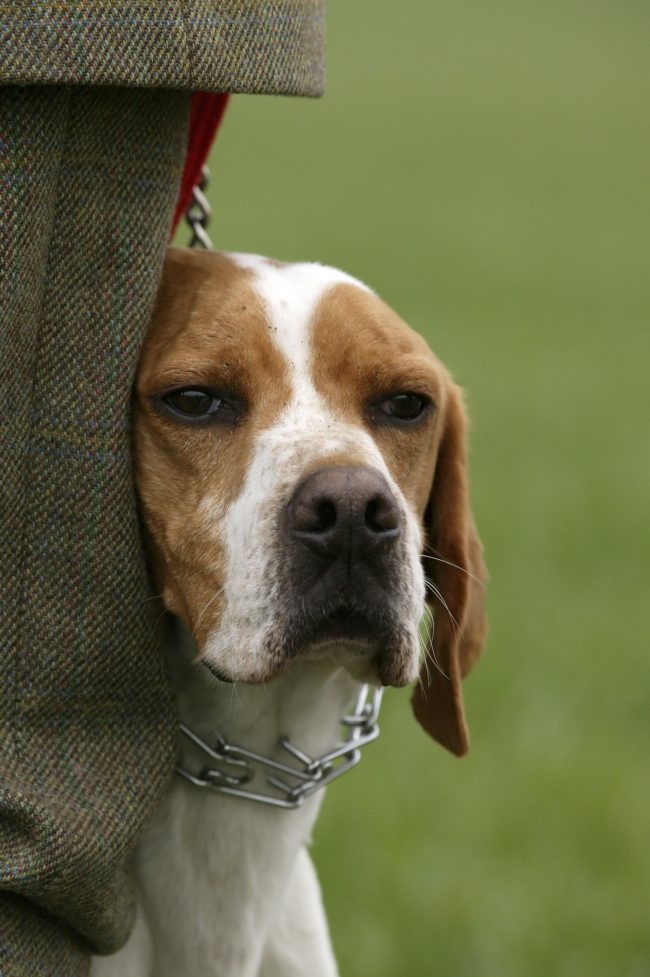
We are unabashed fans of dogs that can do the job for which they were bred, and for that reason, we applaud breed clubs that hold training and/or testing in the disciplines of their respective breeds. From weight pulls for Malamutes to herding tests for herding breeds (and everything in between), there is no better way to remind owners and breeders that most of their breeds weren’t created for a whim.
We pivot to field trials that enable a dog to work in the field in a competitive setting by covering a lot of open ground in a short amount time. Such trials allow dogs to display a keen desire to hunt, along with their native intelligence, and the ability to find game while showing off their style, stamina, and pluck. Some trials are on conducted with handlers on horseback, others on foot.
Among the oldest and most traditional of the field trials is the Pointing Breed field trial. It has its own vernacular (terms like “Stop-to-Flush,” “Blinking Birds,” “Stop-to-Flush,” “Whoa a Dog”), its own etiquette, and certain procedures unique to the sport.
The original AKC trials were for foot handlers. In 1966, AKC regulations were amended to allow horseback handling, and it was such a popular decision that participation in AKC Pointing Breed Field Trials doubled soon after.
AKC Gun Dog Championships began in 1993, an effort to improve and increase the scope of pointing breed field trials. Today, hundreds of AKC Pointing Breed Field Trials are held each year with total entries numbering in the tens of thousands, but as in most things, there had to be a first time, and it might interest readers to know that the first AKC-licensed Pointing Breeds field trial was conducted by the English Setter Club of America in 1924 in Medford, NJ. Mind you, that was not the first one. America’s first recorded field trial was held by the Tennessee State Sportsman’s Association in 1874 near Memphis, Tennessee, a trial won by “Knight,” a solid black setter owned by H.C. Pritchard who scored a total of 88 points out of a possible 100. The event triggered a trend that grew stronger each subsequent year, and a good thing, too, if the “Yanks” were to ever catch up with Britain which held its first recorded Field Trial in 1866.
In the early days, field trials were run under the patronage of “The American Field,” and original field trials were for pointing dogs or “bird dogs” (think English Pointers, most of the setter breeds, and “droppers,” which, according to one source, were unplanned crosses between a purebred pointer and a purebred setter. Not purebred dogs, but dandy gun dogs).
From the days of the Depression through the WWII period, AKC trials rarely exceeded ten events a year, but with the increasedpopularity of “continental” breeds from Europe, the number and frequency of AKC Field Trials jumped markedly after the war. Soon, smaller breed clubs wanted in on the action as they saw the value (and popularity) of the events. In 1943, the American Brittany Club held an event in Ravenna, Ohio, and a year later, the German Shorthaired Pointer Club of America held a field trial in Anoka, Minn.
The decade of the 50s was good for the sport. The American Pointer Club held its first field trial at Fairfield, Connecticut in 1953, and a couple of years later, the Weimaraner Club of America ran a trial in Fort Lewis, Washington. Professional bird dog trainers exploded in numbers in the 50s, in large part because the popularity for training hunting dogs soared. Competing in trials grew in numbers, but it also made winning harder because the dogs got better, as did the methods of training. Conscientious breeders worked to breed proficient dogs, and to reproduce those same traits in their offspring, while trainers “tweaked” what worked, and what didn’t.
It’s a big topic that has filled books, and we must conclude at some point. A good way to end is to pass along the sole purpose of field trialing as written by former a author and trial reporter, William F. Brown:
“The object of field trials is the promotion and development of the high class bird dog. It is a means of enjoying the great out-of-door sport of bird hunting in the most aesthetic fashion. It aims to provide competition of the highest kind among bird dogs, to stimulate enthusiasm among owners, and to act as a practical guide for breeders by setting a high standard of performance.”
Image: Field Trial Dog by © Jack Scrivener | Dreamstime
